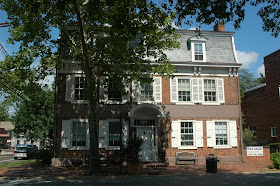 |
| Hopkinson's Bordentown residence, where he presumably wrote his satirical ditties. |
Interestingly, the plaque on his house also noted that he was a 'great satirist,' a designation you don't often see on historic markers. During the Revolutionary War, he wrote several poems to tweak the British, one of which memorializes an act of harassment on the Delaware River that started in Bordentown and ended in Philadelphia.
It all started on January 6, 1778, when a substantial number of ships in the British fleet were located in the Philadelphia harbor. Working at the behest of several patriots, a cooper in Bordentown constructed several kegs which were then loaded with gunpowder and outfitted with trigger mechanisms. These makeshift mines were then floated down the Delaware, intended to detonate and damage British ships which were assumed to be at anchor in the river.
The scheme didn't go quite as planned. Due to icy conditions in the river, the Redcoats had docked most of their ships at port, leaving little opportunity for the kegs to collide with them along the flow of the river. Only one of the incendiary devices exploded, killing four crew members who'd attempted to haul it up onto a British barge.
 In response, British officers ordered their men on shore to fire at any mass floating in the river. Given that it was nighttime, soldiers couldn't differentiate between the kegs and other flotsam, leading them to fire wildly at ice floes and logs as much as the explosive barrels.
In response, British officers ordered their men on shore to fire at any mass floating in the river. Given that it was nighttime, soldiers couldn't differentiate between the kegs and other flotsam, leading them to fire wildly at ice floes and logs as much as the explosive barrels.While the keg plot itself was a failure, Hopkinson saw the episode as opportunity to promote the hapless British response. When you need fodder for propaganda, nothing bolsters the spirits quite like your opponents' miscues. The Battle of the Kegs is a spirited ditty when sung to the tune of Yankee Doodle, though Hopkinson cheated on the meter a bit by including far too many "sirs." By tweaking the poor judgment of the British on that chilly evening, it demonstrated that the Americans weren't cowed by their opponents' military might.
Had Hopkinson been born 250 years later, he might have used his talents on Saturday Night Live. Instead, his poems and songs traveled by word of mouth, encouraging his fellow patriots to continue the fight and consider independence a wholly realistic possibility.
I've got to get back to Bordentown one of these days--like so many other places I thought I 'knew' in NJ, you're helping me see it with new eyes. Great stuff.
ReplyDeleteThanks, Rick! We're glad to give you another reason to check out some of New Jersey's great places.
ReplyDeleteFascinating! History should focus on the stories of people. Particularly national history. You did good...:)
ReplyDeleteThanks, Troutbirder! Glad you enjoyed reading about Hopkinson.
ReplyDelete